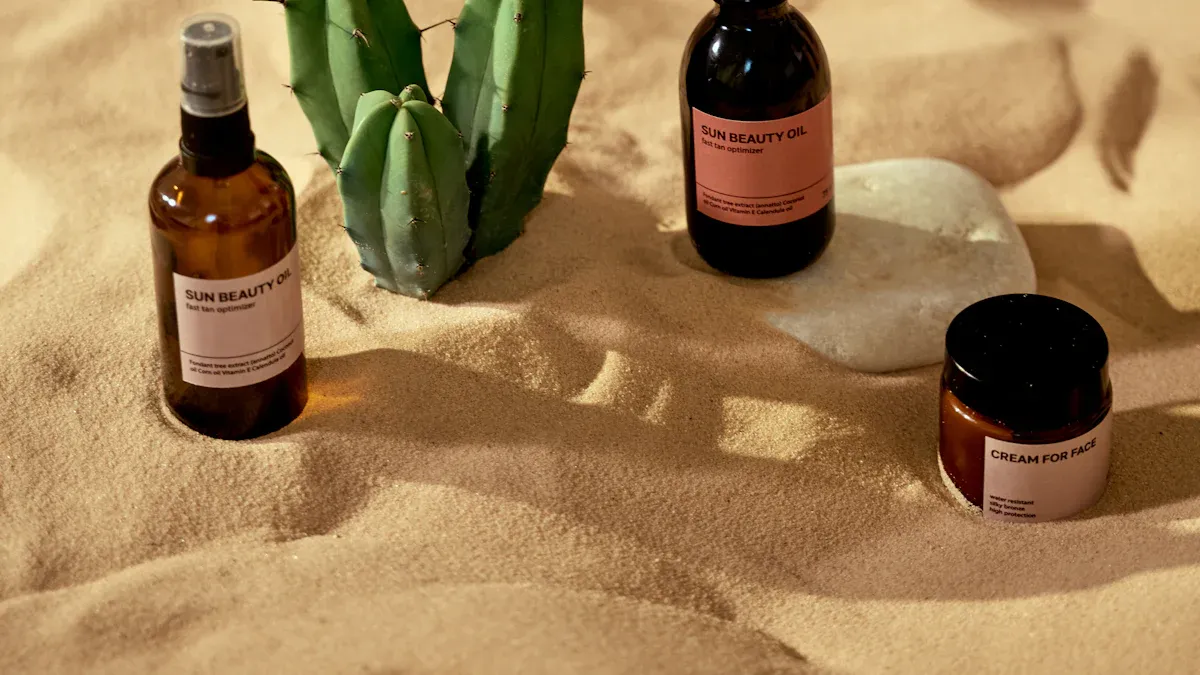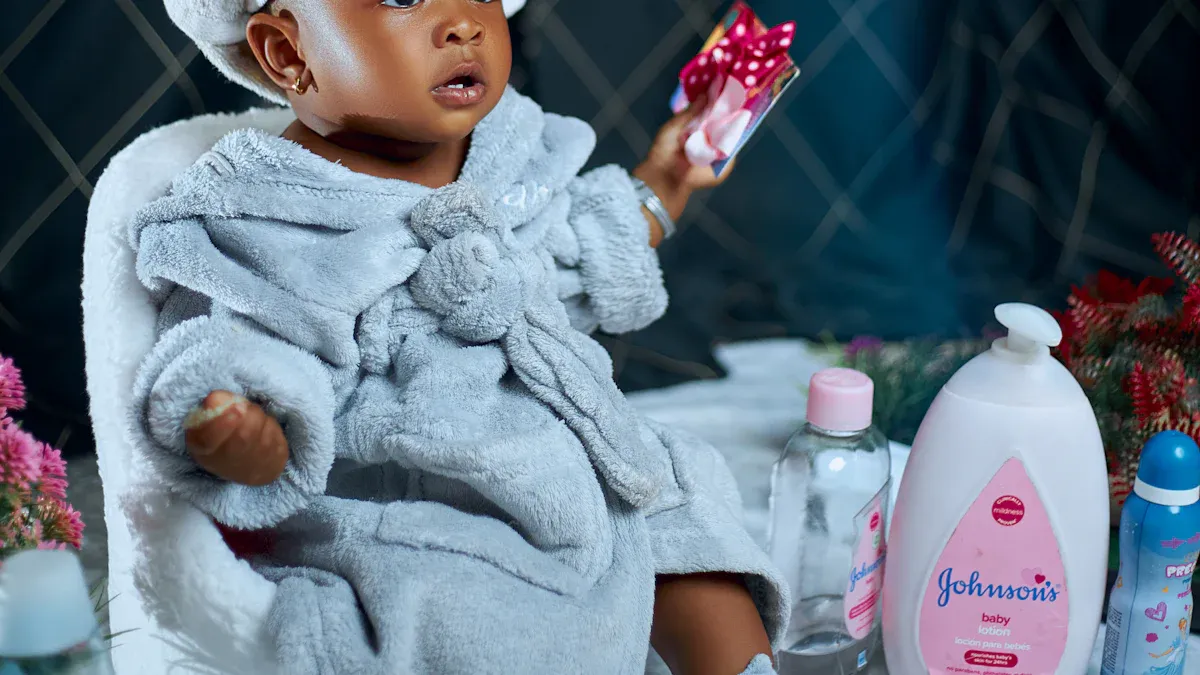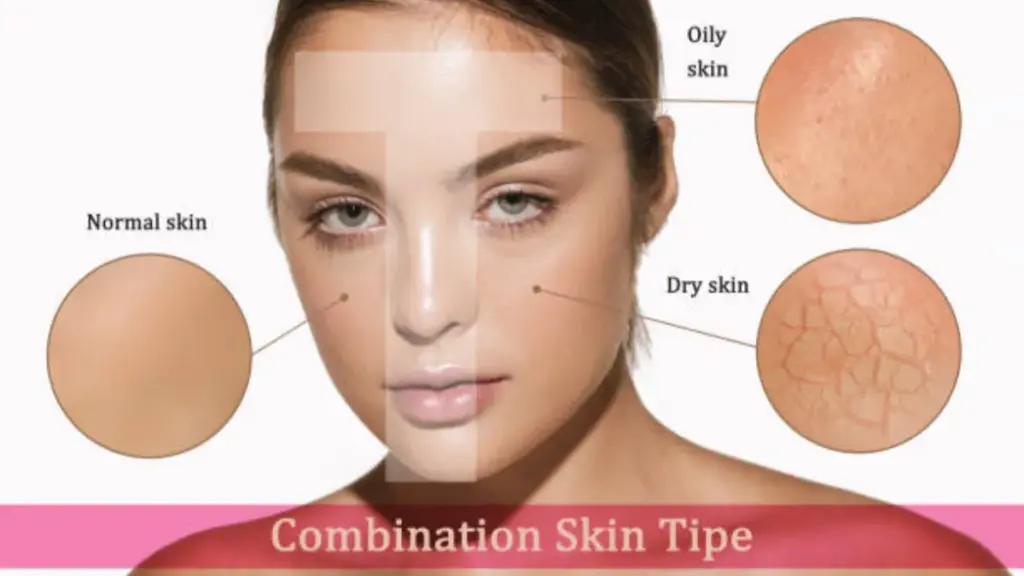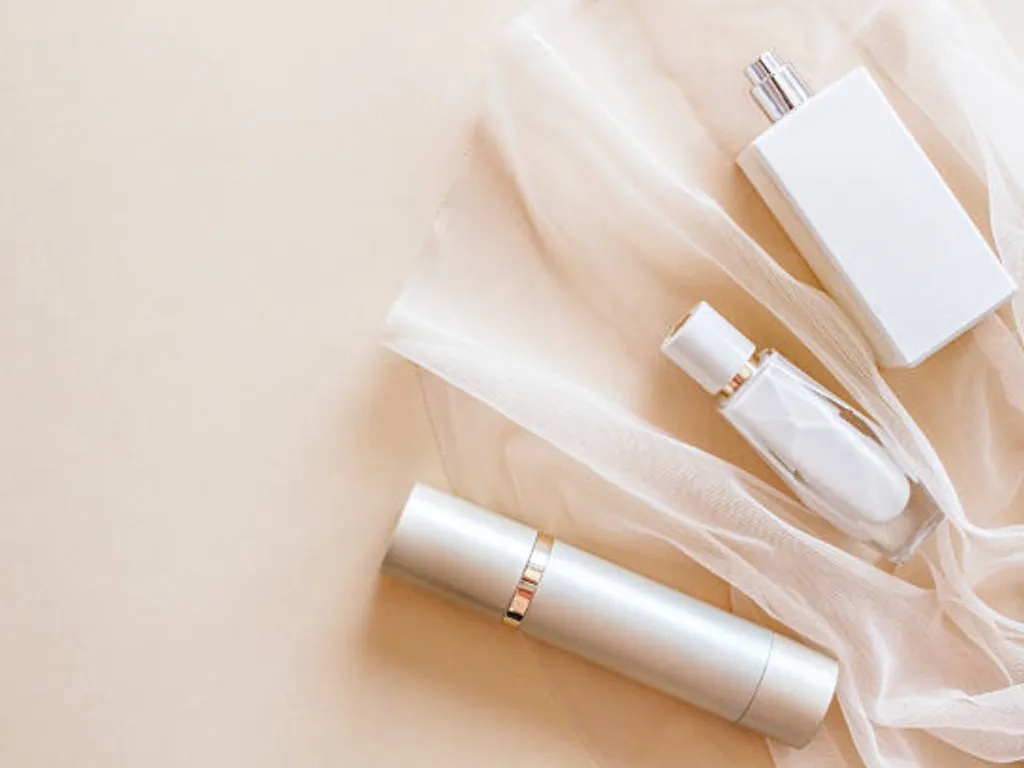
Demand for Natural and Organic Baby Skincare Products
Have you noticed how many parents today are switching to natural and organic skincare for their little ones? This shift isn’t surprising. Parents are becoming more cautious about what touches their baby’s delicate skin. They’re looking for products free from harmful chemicals, and this is fueling the growth of the baby skincare market.
You’ll find that diaper rash creams with natural ingredients like beeswax, calendula oil, and organic oils are becoming household staples. These ingredients not only soothe irritation but also protect sensitive skin. Brands like Earth Mama and Burt’s Bees are leading the way by offering plant-based options that are gentle yet effective. This growing preference for organic products is reshaping the global baby and child skin care products market.
What’s driving this trend? It’s all about awareness. Parents now understand the importance of ingredient safety. They want products that are hypoallergenic and safe for everyday use. This demand is pushing brands to innovate and create skincare solutions that meet these high standards.
Sustainability and Eco-Friendly Innovations
Sustainability is no longer just a buzzword. It’s a priority for many parents and brands targeting children. You’ve probably seen products with eco-friendly packaging or formulations that use fewer preservatives. These innovations are not only better for the environment but also appeal to parents who want to make responsible choices.
على سبيل المثال, powdered skincare products are gaining popularity. They’re environmentally friendly and don’t require preservatives, making them a safer option for babies. Sustainable packaging, like recyclable tubes, is another big hit. It’s cost-effective, safe, and aligns with the values of eco-conscious consumers.
Brands are also focusing on personalized skincare solutions. These cater to individual needs, ensuring that every baby gets the care they deserve. As sustainability continues to shape the child skincare market, you can expect even more creative and eco-friendly solutions in the future.
Social Media’s Role in Shaping Consumer Preferences
Social media has become a powerful tool in the baby skincare market. Platforms like Instagram and TikTok are influencing how parents choose products for their children. You’ve probably come across posts from influencers sharing their favorite baby and child skin care products. These recommendations often feel relatable and trustworthy, making them highly effective.
Local influencers play a big role here. They help brands connect with specific audiences by creating content that resonates with regional preferences. على سبيل المثال, an influencer might highlight the benefits of a natural baby lotion that aligns with cultural beauty standards. This approach helps brands build trust and reach more parents.
Consumer reviews also matter. When parents share their experiences with a product, it creates a ripple effect. Positive reviews can boost a brand’s reputation and encourage others to try the product. Social media has turned into a space where parents exchange tips, making it a key driver in the growth of the global baby and child skin care products market.
Consumer Segmentation
Age Groups and Product Needs
When it comes to baby and child skin care products, age plays a big role in determining what’s needed. Babies, toddlers, and older children all have unique skincare requirements. على سبيل المثال, newborns have ultra-sensitive skin that benefits from gentle, fragrance-free products like baby lotions and diaper creams. Toddlers, على الجانب الآخر, might need sunscreen or moisturizers to protect their more active skin.
Here’s a quick breakdown of how age groups influence product needs:
Age Group | Product Needs |
|---|---|
Babies (0-12 شهور) | Gentle cleansers, diaper rash creams, baby oils |
Toddlers (1-3 سنين) | واقي الشمس, المرطبات, bath products |
Older Children (4+ سنين) | Mild soaps, shampoos, والمستحضرات |
As you can see, each stage of childhood comes with its own skincare priorities. This segmentation helps brands create targeted solutions that cater to specific needs.
Skin Types and Specialized Baby Skincare Solutions
Not all baby skin is the same. Some babies have dry skin, while others might deal with conditions like eczema or dermatitis. This is why specialized skincare solutions are in high demand. Parents are increasingly looking for products tailored to their baby’s unique skin type.
ال 0-6 month age group dominates the market because newborns have the most delicate skin.
Rising cases of skin conditions like eczema are driving demand for dermatologist-approved products.
Many parents prefer natural and organic options to avoid harmful chemicals.
على سبيل المثال, you might notice more brands offering hypoallergenic creams or plant-based balms. These products are designed to soothe irritation and protect sensitive skin. The growing awareness about skin health is pushing the market toward safer, more effective solutions.
Regional and Cultural Trends in Child Skincare
Skincare preferences can vary a lot depending on where you live. In North America and Europe, parents often prioritize premium, organic products. Meanwhile, in regions like Asia Pacific, the market is booming due to rising disposable incomes and a growing focus on baby health.
Here’s a snapshot of some key trends across regions:
Insight | وصف |
|---|---|
Increasing Parental Awareness | Parents are becoming more conscious of the impact of skincare products on their baby’s skin. |
Rise in Organic and Natural Products | There is a growing preference for products free from synthetic ingredients. |
E-commerce Boom | Online platforms provide convenient access to a variety of baby skincare products. |
Product Innovation | Companies are developing innovative products tailored to specific skin concerns. |
These trends show how cultural and regional factors shape the demand for baby and child skin care products. Whether it’s through e-commerce or local stores, parents everywhere are seeking the best for their children’s skin.
Marketing Strategies and Innovations
Influencer Marketing in the Baby Skincare Industry
Influencer marketing has become a game-changer for brands in the baby skincare market. You’ve probably seen parenting influencers sharing their favorite baby products on Instagram or TikTok. These posts feel relatable and trustworthy, which is why they work so well. Brands earn an average of $5.78 for every $1 spent on influencer campaigns. That’s a huge return on investment!
المحتوى الذي تم إنشاؤه بواسطة المستخدم (UGC) also plays a big role. When influencers encourage parents to share their experiences, engagement rates can jump by 50%. على سبيل المثال, one baby skincare brand saw a 250% rise in mentions after hosting an influencer-led giveaway. Collaborating with over 50 parenting influencers helped them achieve 5 million views on campaign hashtags and boosted sales by 280% in just one month.
If you’re a brand looking to grow, influencer marketing is a smart strategy. It builds trust, drives sales, and connects you with your audience in a meaningful way.
E-Commerce and Direct-to-Consumer Models
Shopping for baby skincare products online has never been easier. زيادة 70% of consumers prefer buying skincare products online because it lets them compare prices, read reviews, and explore a wider variety of options. E-commerce sales in the beauty and personal care sector surged by nearly 40% during the pandemic, showing how much people value convenience.
Brands are now investing in direct-to-consumer models to improve customer experience. Subscription services are especially popular. They make life easier for parents by ensuring products like diaper rash creams or baby lotions are always available. Organic baby skincare products are also seeing strong growth, with a projected CAGR of over 10% in the next five years.
If you’re a parent, online shopping gives you access to safe and natural products for your baby. For businesses, it’s a chance to reach more customers and build lasting relationships.
Product Customization and Technological Advancements
Parents love personalized solutions for their baby’s skincare needs. Customization is becoming a big trend, with brands offering products tailored to specific skin concerns like dryness or eczema. Advances in technology are making this possible. على سبيل المثال, AI-powered tools can analyze skin types and recommend the best products.
You’ll also notice innovations in packaging and formulations. Sustainable packaging, like recyclable tubes, appeals to eco-conscious parents. Powdered skincare products are another exciting development. They’re preservative-free and safer for sensitive skin.
Technology is helping brands create smarter, أكثر أمانًا, and more personalized products. As a parent, you can feel confident knowing there’s a solution designed just for your baby.
Challenges in the Growing Market
Ethical Concerns and Ingredient Transparency
You’ve probably noticed how much parents care about what goes into their baby’s skincare products. Ethical concerns and ingredient transparency have become hot topics in this market. Parents want to know exactly what they’re putting on their child’s skin, and they’re not afraid to ask tough questions.
Here’s a quick look at the key issues:
Ethical Concerns | Ingredient Transparency Issues |
|---|---|
Increasing concerns about chemical exposure | Consumers demand detailed ingredient lists due to safety concerns and health awareness. |
Allergens causing skin irritation | Parents seek assurance that products are safe for their children. |
Preference for natural and organic products | Ethical and environmental concerns influence consumer choices and demand for transparency. |
Regulatory scrutiny on labeling | Manufacturers face pressure to demonstrate product safety and ethical practices. |
You can see why brands are under pressure to be more transparent. Parents want products that are safe, natural, and free from harmful chemicals. This demand is reshaping the industry, pushing companies to adopt ethical practices and provide clear ingredient labeling.
Regulatory Compliance and Market Entry Barriers
Navigating regulations in the baby skincare market can feel like walking through a maze. You might not realize it, but strict rules actually help ensure product safety. على سبيل المثال, FDA regulations have encouraged brands to innovate by creating safer, organic options.
لكن, these rules also create challenges, especially for smaller companies. Startups often spend over 20% of their budget on compliance, which slows down their ability to launch new products. International regulations, like the EU’s REACH standards, add another layer of complexity. These rules push manufacturers to prioritize eco-friendly solutions, which can be costly but necessary.
Here’s why compliance matters:
نوع الأدلة | وصف |
|---|---|
Regulatory Compliance | Strict regulations foster innovation by pushing manufacturers to develop safer products. |
Market Entry Barriers | Startups in health sectors allocate زيادة 20% of their budget to compliance, slowing innovation. |
International Regulations | EU’s REACH regulation drives manufacturers to prioritize environmentally friendly solutions. |
Consumer Confidence | 66% of global respondents are willing to pay more for sustainably produced goods. |
For you as a consumer, these regulations mean safer and more sustainable products. For businesses, they’re both a challenge and an opportunity to stand out.
Competition and Market Saturation
The baby skincare market is buzzing with activity, but that also means it’s crowded. You’ve got big names like Johnson & جونسون, لوريال, and Unilever dominating the space. These companies have strong brand recognition and massive distribution networks, making it tough for smaller players to compete.
At the same time, niche brands focusing on organic or hypoallergenic products are carving out their own space. This creates intense competition, leading to price wars and thinner profit margins for everyone.
Here’s what the competitive landscape looks like:
The market is highly competitive, with both established and emerging players fighting for attention.
Major corporations dominate, but smaller niche brands are gaining traction.
Intense competition often results in price wars, which can hurt profitability.
For you as a parent, this competition means more choices and better prices. For businesses, it’s a reminder to stay innovative and find unique ways to stand out in a saturated market.
Future Trends and Opportunities

Advancements in Dermatology for Baby and Child Skincare
The future of baby skincare is looking brighter, thanks to advancements in dermatology. You’ve probably noticed how much parents care about using safe and effective products for their little ones. Dermatologists are stepping up to meet this demand by creating solutions that are not only gentle but also scientifically backed.
Here’s what’s driving these advancements:
The organic baby skincare market is expected to grow from $1.4 مليار في 2022 ل $2.8 مليار من قبل 2030, with a CAGR of 9.1%.
Parents are increasingly aware of the harmful effects of synthetic ingredients. This is pushing brands to focus on natural and organic formulations.
Clean-label products and sustainable packaging are becoming more popular. These trends align with the values of eco-conscious parents.
Dermatologically-tested, hypoallergenic products are in high demand. Parents want skincare solutions free from harmful additives.
You’ll also see more innovation in formulations. Brands are using organic extracts to create products that soothe and protect delicate skin. This shift toward dermatology-driven solutions ensures that your baby’s skin gets the care it truly deserves.
Growth of Premium and Luxury Skincare Lines
Premium and luxury skincare lines for children are no longer just a niche. They’re becoming a major trend in the market. Parents like you are willing to invest in high-quality products that promise better results and safer ingredients.
The numbers speak for themselves. The global baby and child skincare market grew by nearly 9% last year, with premium products making up about 45% of the market. This shows a clear shift toward luxury options. في الحقيقة, three out of four parents say they’re more likely to spend on their children’s personal care products than on their own.
What’s fueling this growth? Social media plays a big role. Celebrity endorsements and influencer recommendations make luxury products more appealing. Affluent parents are also drawn to exclusive, high-end options that reflect their lifestyle. Whether it’s a premium baby lotion or an organic diaper cream, these products offer a blend of quality and sophistication that’s hard to resist.
Integration of Technology in Product Development
Technology is transforming the baby skincare industry in ways you might not have imagined. From personalized solutions to eco-friendly innovations, brands are using cutting-edge tools to create smarter products.
Here’s a quick look at how technology is shaping the future of baby skincare:
Trend/Technology | وصف |
|---|---|
Helps create personalized skincare solutions tailored to individual skin types. | |
Sustainable Practices | Encourages the use of biodegradable packaging and eco-friendly ingredients. |
Precision Medicine | Develops customized dermatological solutions based on genetic and environmental factors. |
Consumer Behavior Analysis | Uses AI to understand preferences and improve product effectiveness. |
Imagine using an app that analyzes your baby’s skin and recommends the perfect product. Or buying a lotion that’s packaged in biodegradable materials, reducing your environmental footprint. These innovations aren’t just futuristic—they’re happening now.
As technology continues to evolve, you can expect even more exciting developments. Whether it’s through AI, الممارسات المستدامة, or precision medicine, the future of baby skincare is all about making products safer, smarter, and more personalized for your little one.
The baby and children’s skincare market is evolving rapidly, driven by a growing focus on safe, مستمر, and innovative solutions. Parents today are more conscious than ever about choosing products that align with their values and protect their children’s health and well being.
The shift toward eco-friendly options is undeniable. Millennial parents are leading this change, مع 93% in Saudi Arabia preferring plastic-free baby wipes. Major brands are stepping up by adopting biodegradable packaging and committing to 100% recyclable materials by 2025.
Natural and organic products are gaining traction, with over 475,000 doctors globally endorsing these safer alternatives. Companies are also reformulating their offerings to exclude harmful chemicals, ensuring better care for delicate skin.
For businesses like Oully, this market presents exciting opportunities. By offering custom solutions and sustainable practices, you can meet the rising demand for ethical and innovative skincare products. The future of this industry lies in building trust and delivering quality that parents can rely on.
التعليمات
What are the best skincare products for newborns?
Newborns have delicate skin that needs extra care. Look for fragrance-free and hypoallergenic products like gentle cleansers or baby lotions. Avoid anything with harsh chemicals. Always test a small amount first to ensure it suits your baby’s sensitive skin.
How often should I moisturize my infant’s skin?
Infants benefit from daily moisturizing, especially after baths. Use a gentle, baby-safe moisturizer to keep their skin hydrated. If your baby has dry patches or sensitive areas, apply the lotion more frequently to soothe and protect their skin.
Are natural products better for toddlers?
نعم, natural products are often better for toddlers. They’re free from harmful chemicals and gentle on active, growing skin. Look for plant-based ingredients like aloe vera or chamomile. These options are safer and reduce the risk of irritation.
Can I use sunscreen on my baby?
For babies under six months, avoid sunscreen and rely on shade and protective clothing. For older infants and toddlers, choose a mineral-based sunscreen with zinc oxide. It’s safer for sensitive skin and provides effective sun protection.
How do I know if a product is safe for my child?
Check the label for terms like “hypoallergenic” and “dermatologist-tested.” Avoid products with parabens, sulfates, or artificial fragrances. Reading reviews and consulting your pediatrician can also help you make informed choices.
















